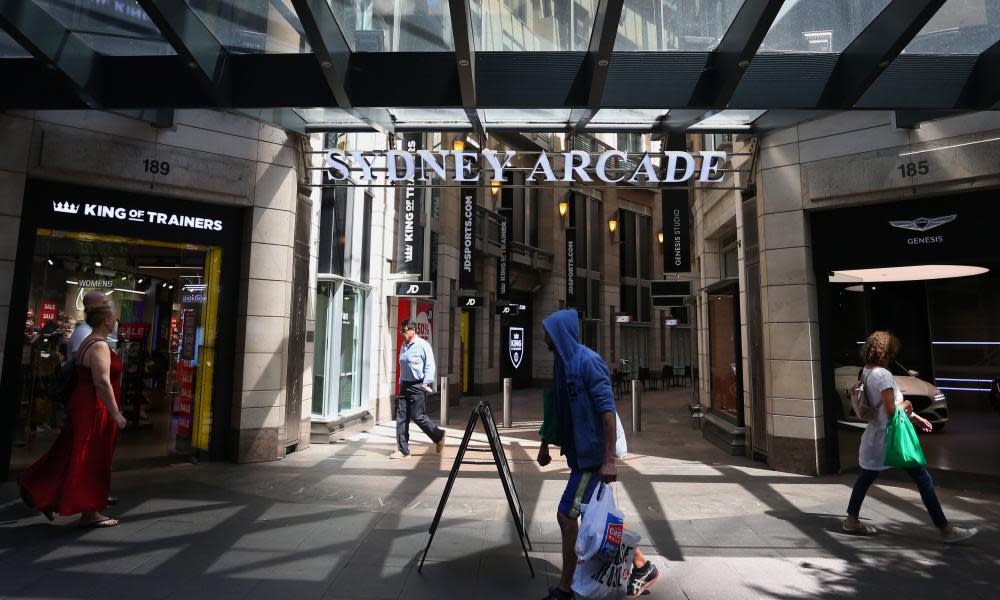Australia’s GDP falls by 1.9% as Covid contraction less severe than feared

Result surprises economists, who mostly tipped a 2.5%-3% contraction
Australia’s second economic contraction caused by Covid has been less severe than feared as increased public spending and a swelling trade surplus cushioned a steep drop in household spending during the east coast lockdowns.
The September quarter national accounts, released on Wednesday by the Australian Bureau of Statistics, showed gross domestic product fell 1.9% compared with the previous three months.
That result surprised economists who had mostly tipped a 2.5%-3% contraction. At an annual rate, the economy expanded at a 3.9% clip.
Still, the quarterly contraction still made it the third steepest on records going back 62 years. The worst fall was the 7% dive during the 2020 June quarter as the first Covid wave crested, while the June quarter of 1974 recorded a 2% retreat.
“Given the backdrop of lockdowns in NSW, Victoria and the ACT, this is an impressively strong performance,” said Sarah Hunter, chief Australia economist for BIS Oxford Economics.
The relatively resilient result for the September quarter provided a better platform for an economic recovery that is firmly under way. But this week’s emergence of the new Omicron Covid variant is a reminder that health risks remain very current.
Still, the signs are that the economy was already well primed for a rebound. Household consumption grew 0.7% in parts of the nation that dodged the extended lockdowns in the September quarter. That expansion helped make up for the 8.4% drop of such spending in NSW, Victoria and the ACT.
“This outcome highlights that once restrictions are eased and the virus is under control (either through low case numbers or high vaccination rates), the economy can recover rapidly,” Hunter said. “This finding is increasingly being confirmed by the labour market and retail spending data, and it’s likely that there will be a sharp turnaround in GDP in the December quarter.”
Extra public spending helped keep the economy moving in the quarter, adding 0.7 percentage points to the growth rate. A swelling current account trade surplus, reaching a record $23.9bn in the quarter also added another 1 percentage point.
Westpac economist Andrew Hanlan said a near doubling in the household savings rate to 19.8% as locked-down consumers curbed their shopping, and government payments rolled out, points to a swift recovery in spending that will bolster the economy.
“Going forward, this sizeable household savings buffer will be drawn upon to help fund future spending – thereby supporting a strong rebound,” he said, adding the necessary qualifier that “this is subject to developments on the health front regarding the virus”.
A quicker than predicted recovery could add to concerns that inflation will rise faster than currently forecast, prompting the Reserve Bank to move sooner to raise its record-low interest rates that now stand at just 0.1%.
Soaring property prices, though, may be easing as a threat, according to the latest national home value index from CoreLogic out today.
It showed that while prices rose for a 14th consecutive month in November, the pace has slowed to 1.3%, the lowest since January.
Still, they are 22.2% higher for the year, lifting the median home value by $126,700.
One thing economists are not so sure about is how much those rising house prices will translate into higher consumption because of the presumed “wealth effect”.
Gareth Aird, the Commonwealth Bank’s chief Australian economics, said markets were trying to assess what the outlook means for prices and wages in the economy.
“Our expectation is that a very strong economic expansion next year will be accompanied by an acceleration in inflation and wages growth,” Aird said. “On our figuring the unemployment rate will drop quite quickly from here and we expect the Australian economy to be at full employment by late 2022.
“As such, our central scenario sees the RBA commence normalising the cash rate in November 2022.”
Deloitte Access Economics’ partner Chris Richardson said the recovery from the Covid Delta strain had been even faster than Australia’s rebound through to mid-2021.
“Australian families and businesses are getting better at juggling COVID. The pain this time around was less, and the recovery looks set to be even faster,” he said, adding his consultancy predicts the December quarter will claw back a gain of 2.0% when those accounts land in early February.

 Yahoo Movies
Yahoo Movies 
